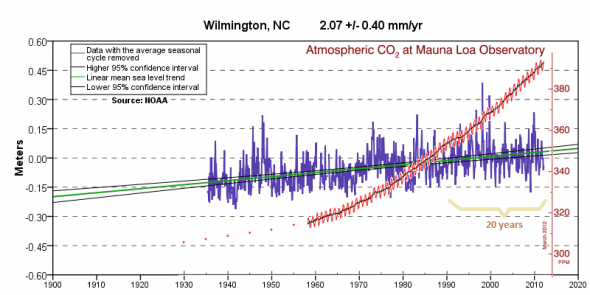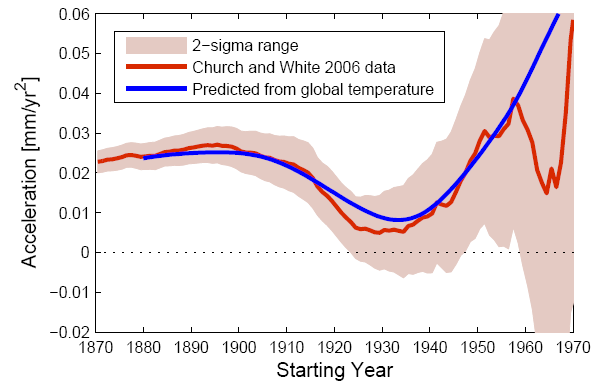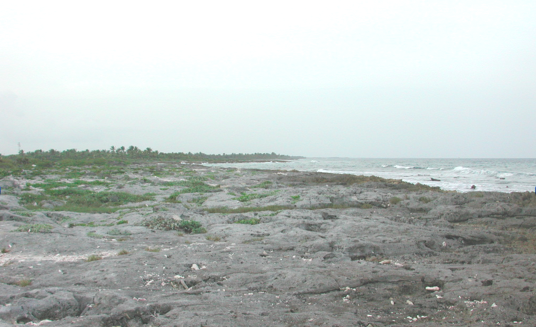Dave Burton of NC 20 published a reply here to recent post I did about natural and human-caused sea level rise, “Sea Level Rise 101“. This is a reply to his post and a clarification of some of his many misconceptions about sea level rise science.
I want to start by saying that my interests in the NC sea level rise issue are not at all political. I am neutral on what coastal communities should do as adaptation measures to sea level rise and other impacts of climate change. I also have mixed opinions about what role the state and federal government should play in such social adaptation (i.e., I am not condoning any changes in coastal regulatory policy). My only interest in this issue is science and truth. The people of North Carolina – indeed the members of NC 20 – should know about the real science of sea level rise. Not the junk science being created and promoted by climate change deniers like Dave Burton and John Droz, Jr.
Now, on to Dave’s response. First up, this graphic:
The legend in Dave’s response was “Juxtaposition of rising CO2 levels (in red) with sea level (in purple) at Wilmington. Sea level has obviously been unaffected by CO2“. Assuming the data are accurate, plotted correctly, etc., is looks to me like this graphic demonstrates exactly what I said about sea level: it is rising (mainly because we are warming the earth). Dave’s graphic is also completely concordant with the core findings of the North Carolina Sea-Level Rise Assessment Report prepared by the N.C. Coastal Resources Commission’s Science Panel on Coastal Hazards that found that based on the Wilmington tide gage, sea level rose at 2.12 mm/yr between 1935 and 2002 (the table below is from page 9 of the report). Also note that sea level is rising more quickly in the north, at ~ 3-5 mm/yr, which is quite a good clip.
 An important piece of background information is that North Carolina is somewhat unique (in a global sense) in that our portion of the continent is subsiding (sinking) at about 1 mm/yr due to a natural process called “glacial isostatic adjustment“. Only about half of the sea level rise in Wilmington can be attributed to greenhouse gas emissions and global warming, although, the manmade fraction is obviously much greater in the northern countries.
An important piece of background information is that North Carolina is somewhat unique (in a global sense) in that our portion of the continent is subsiding (sinking) at about 1 mm/yr due to a natural process called “glacial isostatic adjustment“. Only about half of the sea level rise in Wilmington can be attributed to greenhouse gas emissions and global warming, although, the manmade fraction is obviously much greater in the northern countries.
1. Claim: “These rapid increases in sea level are – as you might have guessed – caused by the rapid melting of glaciers.”
Wrong. The big rise in sea level in prehistoric times was due to the melting of enormous ice sheets which covered much of the globe, as far south as today’s New York City. It was not due to the tiny changes in advance and retreat of glaciers that we see these days.
This is pure semantics. Whether you call them “glaciers” or “enormous ice sheets” is irrelevant. We are in total agreement (and I am not “Wrong”).
There are only two places left where there are really large amounts of water locked up in grounded ice: Antarctica and Greenland.
True
Neither will melt anytime soon.
I hope Dave is correct – unfortunately I doubt he is. Nobody knows for sure whether Antarctica and Greenland will loose ice in the coming decades and centuries. When they do is almost entirely dependent on how much carbon dioxide we emit and how much the earth warms. Furthermore, the existing science strongly suggests that both Greenland and Antarctica already are loosing substantial mass due to global warming. Stating “Neither will melt anytime soon” is not based on science and at best is a highly optimistic opinion.
Even the alarmist IPCC’s TAR noted, “It is now widely agreed that major loss of grounded ice and accelerated sea level rise [from the West Antarctic Ice Sheet] are very unlikely during the 21st century.” (The larger East Antarctic Ice Sheet is the coldest place on earth, and hasn’t melted in millions of years.)
A lot has changed since “TAR” (AKA the IPCC Third Assessment Report) was published 11 years ago. In fact, the science of sea level rise and Greenland and Antarctic melting has changed profoundly since the AR4 was published in 2007.
Nor is Greenland a cause for worry. Greenland is colder now than it was in the 1930s and 1940s, and much colder than during the Medieval Warm Period (~800-1100 yrs ago), neither of which saw catastrophic sea level rise from any Greenland ice sheet “tipping point.”
In fact, as described in the North Carolina Sea-Level Rise Assessment Report, sea level in North Carolina (and elsewhere) did in fact change in response to this short-term, regional (non-global) warming: “Kemp (2009 thesis) presented continuous, high resolution constructions of SLR in North Carolina for the past 2,000 years using geological data from Sand Point (Roanoke Island) and Tump Point (Cedar Island). The rate of RSL rise was close to 1mm per year (4 inches/century) for most of this period. The rate almost doubled to 1.7mm per year (6.7 inches/century) for about 350 years during the Medieval Warm Period (AD 1000 to 1350), and then returned to 1.0 mm/yr for the next few centuries. The rate then increased in the 20th century to about 3.2 mm per year (12.6 inches/century).”
In other words, the scientific record indicates that the Medieval Warm Period suggests: 1) that Greenland ice mass is indeed sensitive to temperature and 2) that sea level is as well.
2. Claim: “Greenhouse gas emissions are causing sea level to rise via “thermal expansion” (warming a liquid increases it’s volume) and by melting mountain glaciers. Until human activities increased the concentration of greenhouse gases in the earth’s atmosphere, global sea level had been relatively stable for several thousand years…”
Wrong. Although the average rate of sea level rise increased as the Little Ice Age ended, ALL of the acceleration in rate of sea level rise occurred BEFORE there was a substantial anthropogenic CO2 contribution. The big increase in atmospheric CO2 levels over the last 3/4 century has not resulted in ANY acceleration in the rate of sea level rise.
The TAR noted the “observational finding of no acceleration in sea level rise during the 20th century.”
1) As noted, the science of sea level has come a long way since the 1990s, and the available science indicates that there has been an acceleration in sea level rise during the 20th century, for more on this, go here, here, here, here, here, and here.
2) I think we have gotten to the core of Dave’s misconceptions about sea level rise and it’s relationship to greenhouse gas emissions and global warming (and of his misinterpretation of his graphic above). Dave seems to mistakingly think that only an acceleration of sea level rise could be evidence of a human cause. Not true. Scientists know that current global sea level rise (not an acceleration in it) itself is caused by global warming. The concern is that it would be really bad if sea level rise accelerates in coming years beyond what we are already experiencing. The big debate over the melting of Greenland and Antarctica is that this would drive an acceleration, i.e., a non-linerar response to warming. (as I explain here, thermal expansion and the melting of mountain glaciers seem to be enough to cause a linear increase).
Moreover, although thermal expansion does cause satellite-measured mid-ocean sea level to rise, it does not necessarily cause coastal sea level to rise. If deep-ocean water were to expand, it would, indeed, affect coastal sea levels. But when surface water warms, it rises in place, like ice, and its displacement is unaffected, so it does not affect coastal sea levels.
I probably don’t need to point out the flaw in this crazy logic to many SeaMonster readers. Besides, the deep ocean is warming.
Claim: “The rate of sea level rise appears to be accelerating”
Wrong. Both tide gauges records and satellites show NO statistically significant acceleration over the last 3/4 century. The best studies show either linear trend or a slight deceleration.
There are quite a few papers, analyses, and lines of evidence that indicate a recent (20th century) acceleration of sea level rise, e.g., here, here, here, here, here, and here. One study (Houston and Dean 2011) that deniers often point to has been formally debunked (here) for gross cherry-picking and because the authors failed to perform an essential data correction for water storage artifacts. (Only during the time interval used by the authors, was there any hint of a deceleration. For most time periods, there was indeed an obvious acceleration – see the graph below from here).

5a. Claim: “How much sea level rise should we expect this century? … Observed sea level rise is tracking at the upper range of model predictions…”
Wrong. Your fig. 6 conflates tide gauge and satellite measurements, creating the ILLUSION of acceleration where none actually exists.
First, it is not “wrong” that “Observed sea level rise is tracking at the upper range of model predictions…” – they are. This is indisputable (see the figure below). Second, my Fig. 6 does not “conflate” tide gage and satellite measurements: it overlaid them to show both methods lead to the same conclusions: sea level is rising (in fact the satellite measurements are calibrated to the tide gauge data). Third, the expectation that, regardless of what happened in the 20th century, sea level rise is likely to accelerate is based on physics, not on Fig. 6. And no, evidence for sea level rise acceleration is not based on combining tide gauge and satellite measurements.
a graph of just 40 years is insufficient to discern long term trends,
The reason this graph (below) only covers 40 years is that it is meant to show how poorly the most recent (from AR4) IPCC sea level models predicted recently observed sea level rise (the models have underestimated it, we think because they did not include melting of Greenland and Antarctica). In fact, really only the latter 20 years are important. The intent of the graph was not to demonstrate a trend in sea level (only to compare it to the models).

5b. Claim: “An alternative way to predict future sea level rise is from the known relationship between sea level and global temperature from the recent and distant past (Vermeer 2009)…”
Wrong. The Rahmstorf/Vermeer approach has been thoroughly discredited, and that Fig. 7 graph is nonsense. If you look at real tide gauge data from the best tide gauges, it looks nothing at all like that. E.g.,
The graph (from this article) is not “nonsense” – it is science. Furthermore, pointing out that a single local time series does not correspond with a widely-accepted global pattern does not undermine our acceptance of the latter. We know there is lots of local variability in sea level rise, warming, weather, etc. Nobody and no theory suggests otherwise. Your argument is an obvious straw man.
I’d like to see the peer-reviewed articles in which they were “thoroughly discredited”. In fact, there really is no denying that there is a strong relationship between global temperature and sea level, which is all they argued. (This is just fundamental physics and geoscience and frankly common sense). Dave made the same augment himself at the beginning of his piece;
The big rise in sea level in prehistoric times was due to the melting of enormous ice sheets which covered much of the globe, as far south as today’s New York City
Indeed. And the melting of those ice sheet was due to the subtle warming of the earth. The Vermeer and Rahmstorf (2009) approach is really just one of many formal quantifications of a phenomena geologists have been aware of for many decades.
Here is a far cruder but equally sound version of the approach: Because the earth’s temperature was ~1 C warmer 120,000 years ago during the last interglacial (the Eemian epoch), global sea level was about 6 m (~20 feet) higher than it is now. Evidence of this can be seen in Florida and all around the Caribbean in fossil (120,000 year old) coral reefs that are left high and dry above the current high tide mark, such as in the image below that I took along the Yucatan:
Prudence, logic, and science suggest that, were the earth to warm this much in coming centuries (a near-certainty), the equilibrium sea level could be roughly the same. This doesn’t tell us how fast it would happen. But as I explained here, only 15,000 years ago during “Meltwater Pulse 1A” sea level increased by at least one to two feet per decade! The Eemian is far from a perfect analogue for the Holocene (the current geological era). But lessons from the Eemian are one of the many reasons that scientists just don’t wanna go there. We don’t know with great certainty that even modest global warming would lead to ~ 6 m in sea level rise – but it is very much possible.
*Note, this post is closed for comments. The SeaMonster team has been deluged with denialist harassment and threats and we don’t have the time to moderate all the craziness that is coming in. I plan to repost this piece on SkepticalScience, where we have a comment moderation team in place; deniers can comment there within the limits of the SkS comment policy.
